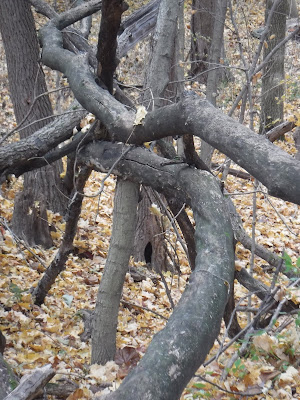15-Day Sit Spot
Challenge
Days #5 and #6
November 11 and 12,
2018
The saga continues, of the Sit Spot
Challenge through the Wilderness Awareness School.
Please see my first entry of this
series for an introductory explanation.
Day #5
November 11, 2018
Almost 6:00 pm Eastern
Standard
Prompt for Day #5: What patterns are
you beginning to notice at your spot?
It was a cloudy day – cold, but not
bitter.
The now dense
leaf cover on the woodland floor was very dry. As I started down the
slope, I again heard the squeak-snort of a deer on the opposite side
of the woods, along the deer trail, warning me. The leaves were so
loudly crunchy that I barely walked into the woods before the deer
was alerted. I could not see the deer, though, despite the thinning
woods.
A few moments later, Silas started down
the slope to join me. Even his lighter cat feet on the leaves alerted
the deer, which snorted again!
I could not get to the woods until
evening, when color was already appearing on the western horizon. I
would not be able to spend much time at the spot across the woods and
get back before dark. So, I chose a spot on the near side, just below
the house, where I could see my spot far across the way.
The woodland slope to the southeast
I sat on the dry woods floor and
watched. The floor was all golden and amber. It was nice to see
things from an animal's point of view, closer to the ground.
The woodland seemed even smaller, as it
was more open than the day before. It wasn't long ago that I would
not have been able to see beyond the center of the woods, if that far.
I heard a faint chirping, but otherwise
the woodland was quiet, as wildlife was settling in for the night.
Later, the nocturnal wildlife would be out and about, but I would be
inside the house by then.
I got up to leave, and saw that I had
left an impression in the leaves of the woods floor – just like a
resting deer.
Day #6
November 12, 2018
Mid-morning
Four trees in a row near the top end of my Sit Spot log: Sugar Maple, Tuliptree, Black Cherry, Chinquapin Oak
Prompt for Day #6: See if you can
notice three more things you've never really noticed before at your
spot.
It was a very cold day, with a striated
cloud cover. I could feel the wind through the canopy from the
northeast.
The challenge is to find three things I
have never noticed before at this spot – but, of course, I find a
number of things!
But, to focus on three:
This little leaf had been
shoved onto the bark of a nearby tree, presumably by wind at some
time. This little leaf has stories (besides the windy experience).
Over the summer, insects have chewed clean circles off of its margins
(maybe a leaf-cutter bee), and another kind of insect has chewed
small holes in the interior. I also love the rough, deep texture of
this tree bark, contrasting with the smooth, shiny texture of the
leaf.
I found a hole at the base of
this tree that grows beyond the tangle of fallen limbs near my spot.
Who lives there? Anyone? Or could it just be used for safety and
temporary shelter? Or as an easy way to get up the inside of the tree
to a place higher up? How did this hole form?
Another tree near my spot –
I think a Sassafras – has a row of woodpecker holes above the base.
I'm almost sure these were made by Pileated Woodpeckers, which tend
to like Sassafrass trees for the carpenter ants they find inside.
Since these holes are so low on the tree, they were created to search
for food, not to create shelter or a nesting place.
Now that I have chosen three things,
here are some other things I discovered around my spot:
A beautiful White Oak leaf,
with magenta and green, and a light streak up the mid-vein. It
contrasts nicely with the surrounding leaves.
A Maple leaf. It looks much
like that of a Black Maple, due to the shape and color. There is a
Black Maple at the edge of our woods, but the Maples inside the woods
tend to be Sugar Maples. Which is it??
A young tree starting out its
life near my spot. I'm sure this is a Chinquapin Oak, and I wish it
much success. Just think how big it could be someday! Since we have been clearing invasive plants from our
woods (mainly Asian Bush Honeysuckle), seedlings and saplings stand a
greater chance of maturing.
The bark of this Tuliptree
(center) has a twisted pattern almost all the way up.
On the way out of the woods:
This old, rotting stump has a
persistent, lighter colored section that almost looks like an attached chimney.
(Here's a look at the other
side)
Obviously, the deer have been
along their trail today.
It was time to head back to our warm
house.

















No comments:
Post a Comment